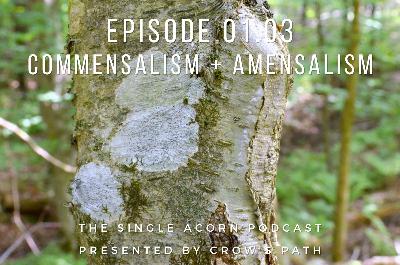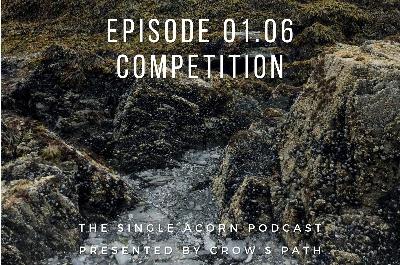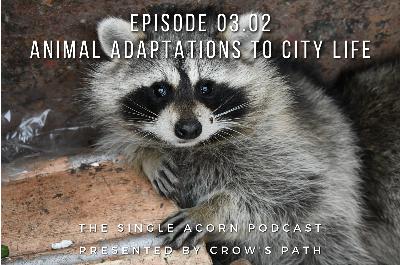Discover The Single Acorn
The Single Acorn

The Single Acorn
Author: Crow's Path
Subscribed: 6Played: 115Subscribe
Share
© 2021 Crow's Path
Description
This is The Single Acorn podcast, a podcast for those of us who love to ponder the world around us, who slowly walk through a forest with the question “Why?” as our constant companion, who are drawn to the tough, weird, gross, and fascinating questions about the natural world.
Each season will cover a topic within natural history (Season 1: Symbiosis, Season 2: Scat, Season 3: Urban Wildlife). So whether your curious about why some trees change sex or why parasitic castration is an effective strategy for some barnacles or why turkey vultures poop on their legs, then this is the podcast for you.
So then, teachers, students, gardeners, foresters, and naturalists, get out your field notebook and join us on a deep dive into the natural history and ecology of our wild neighbors.
Each season will cover a topic within natural history (Season 1: Symbiosis, Season 2: Scat, Season 3: Urban Wildlife). So whether your curious about why some trees change sex or why parasitic castration is an effective strategy for some barnacles or why turkey vultures poop on their legs, then this is the podcast for you.
So then, teachers, students, gardeners, foresters, and naturalists, get out your field notebook and join us on a deep dive into the natural history and ecology of our wild neighbors.
27 Episodes
Reverse
Woohoo! It's finally here. We've been putting in a ton of work behind the scenes to get the new Crow's Path natural history podcast off the ground. And now it's launch time! Check out the trailer, download past episodes, and be sure to subscribe to the podcast on your favorite podcast app. Enjoy!
There is a growing body of evidence that illuminates just how deeply and complexly interconnected organisms are to one another. As scientists uncover these interdependencies, we’re beginning to see how fundamentally different our world would be without symbioses. We would not have the forests of today with mycorrhizal connections running through the soil, we would not have cows, termites, or rabbits without the powerful digestive processes of bacteria, and we wouldn’t even have multicellular life if not for symbiotic bacteria that power photosynthesis (chloroplasts) and metabolism (mitochondria). Many of these lasting interactions across species lines are beneficial to both organisms involved (symbionts), but in the everlasting evolutionary arms race to survive long enough to produce offspring, organisms have devised endless adaptations to exploit other species. Welcome to the Single Acorn.
In this series on symbiosis, we’re taking a deep dive into the many different types of relationships organisms have evolved into, the good, the bad, the benign. This episode highlights mutualisms, those relationships where both organisms involved benefit. We look at the broad categories of mutualism (service vs resource), discuss the evolutionary origins of multicellular life, and how the organisms involved (the symbionts) are in a constant battle to try and out-exploit the other symbiont. Welcome to The Single Acorn.
In this series on symbiosis, we’re taking a deep dive into the many different types of relationships organisms have evolved into, the good, the bad, the benign. This episode highlights relationships in which one partner’s a total dud: behold the neutral symbiont. The relationships can be the result of complete and totally unbalanced competition where the other symbiont is harmed (amensalism) or when one species exploits and is benefitted by the resources offered up by the other at no cost to the latter (commensalism: think dung beetles). No species is entirely isolated from the impact of another organism in its environment so we’ll talk about that gray space between commensalism and mutualism, amensalism and exploitation. Welcome to the Single Acorn.
In this series on symbiosis, we’re taking a deep dive into the many different types of relationships organisms have evolved into, the good, the bad, the benign. This episode highlights relationships in which one partner’s a total dud: behold the neutral symbiont. The relationships can be the result of complete and totally unbalanced competition where the other symbiont is harmed (amensalism) or when one species exploits and is benefitted by the resources offered up by the other at no cost to the latter (commensalism: think dung beetles). No species is entirely isolated from the impact of another organism in its environment so we’ll talk about that gray space between commensalism and mutualism, amensalism and exploitation. Welcome to the Single Acorn.
In this series on symbiosis, we’re taking a deep dive into the many different types of relationships organisms have evolved into, the good, the bad, the benign. This episode highlights relationships in which one partner’s a total dud: behold the neutral symbiont. The relationships can be the result of complete and totally unbalanced competition where the other symbiont is harmed (amensalism) or when one species exploits and is benefitted by the resources offered up by the other at no cost to the latter (commensalism: think dung beetles). No species is entirely isolated from the impact of another organism in its environment so we’ll talk about that gray space between commensalism and mutualism, amensalism and exploitation. Welcome to the Single Acorn.
In this series on symbiosis, we’re taking a deep dive into the many different types of relationships organisms have evolved into, the good, the bad, the benign. This episode highlights relationships in which one partner’s a total dud: behold the neutral symbiont. The relationships can be the result of complete and totally unbalanced competition where the other symbiont is harmed (amensalism) or when one species exploits and is benefitted by the resources offered up by the other at no cost to the latter (commensalism: think dung beetles). No species is entirely isolated from the impact of another organism in its environment so we’ll talk about that gray space between commensalism and mutualism, amensalism and exploitation. Welcome to the Single Acorn.
In this series on symbiosis, we’re taking a deep dive into the many different types of relationships organisms have evolved into, the good, the bad, the benign. This episode highlights relationships in which one partner’s a total dud: behold the neutral symbiont. The relationships can be the result of complete and totally unbalanced competition where the other symbiont is harmed (amensalism) or when one species exploits and is benefitted by the resources offered up by the other at no cost to the latter (commensalism: think dung beetles). No species is entirely isolated from the impact of another organism in its environment so we’ll talk about that gray space between commensalism and mutualism, amensalism and exploitation. Welcome to the Single Acorn.
What goes in must come out. And apparently what goes out can also come in again. That’s right. Poop. The forbidden snack. It’s gross enough to think about poop on its own, but there’s a certain unmatched biological revulsion that bubbles up when I think about eating poop. Or not that I think about eating poop, but when I do research on other animals that eat poop. As I’m chewing on these words, trying to figure out a way to frame this delicately, my dog’s looking up at me in utter confusion. We share a lot in common - a love for adventure, a passion for splashing in puddles, . But we just can’t share that same predilection for caprophagy. We’ll Boots, my poop-eating pooch, this one’s for you. This is the Single Acorn Podscat.
No beating around the bush here. It’s time to get our hands dirty, digging into the wild world of waste. In this season we’re covering the all that of scat, the scoop on poop, giving you some words on turds and theses on feces. We’ve got a whole file of puns and a pile of fun, and lots of fascinating fecal facts that are nuttier than squirrel scat. So join us on a dive into the stinky nethers of nature’s bowels. This is the Single Acorn Podscat.
What goes in must come out. And apparently what goes out can also come in again. That’s right. Poop. The forbidden snack. It’s gross enough to think about poop on its own, but there’s a certain unmatched biological revulsion that bubbles up when I think about eating poop. Or not that I think about eating poop, but when I do research on other animals that eat poop. As I’m chewing on these words, trying to figure out a way to frame this delicately, my dog’s looking up at me in utter confusion. We share a lot in common - a love for adventure, a passion for splashing in puddles, . But we just can’t share that same predilection for caprophagy. We’ll Boots, my poop-eating pooch, this one’s for you. This is the Single Acorn Podscat.
This land is my land, that land is your land. Or so says the freshy pile of stinky excrement on top of the rock in the middle of the trail. For the more reclusive misanthropes of the animal world, their waste does all the talking. Whether it’s for sex, territory, or just to check in, animals can turn their 1s and 2s into As, Bs, and Cs. Learn to read the signs in the scat on this the Single Acorn Podscat.
A rose by any other name would smell as sweet. But that rose would still have to poop. Well, sort of. While we might not think of plants as producing poop, they’re not free of the inefficiencies of a metabolic life. In the green world, life is anything but easy in, easy out, and in this episode, we’ll look at the many ways that plants “poop” or at least how they deal with the things they’d rather not leave lying around. This is the Single Acorn Podscat.
Behold nature, red in tooth and bowel. There’s fierce competition in the green world for the amorous affections of their animal neighbors to pollinate their flowers. And on the heels of pollination comes an equally fierce battle where plants try to win a one way trip down a furry, scaly, or feathery beasts digestive tract. It’s plants, animals, and a big pile of poop. This is the Single Acorn Podscat.
They paved over paradise and put up a parking lot. But what exactly paradise is, is entirely subjective. The good of the scorpion is not the good of the frog. And so as wildlands have dwindled across the blue planet, an asphalt jungle has emerged. It’s a land of milk and honey for those willing to weather the risks. Here we consider the hazards these fearless explorers face. This is the Single Acorn Podcast.
Windows and Toxins, and Cars oh my. Yeesh - City life sure is tough. And not everyone’s up to the task of living like City Mouse. So what makes City Mouse so good at city living? In this episode we lay out the Urban Wildlife Syndrome - some of the common patterns, behaviors, and adaptations wildlife have that make the city life the good life. This is the Single Acorn Podcast.
In the shadows of our psyche lives a creature. Its form is dark, its features obscure, its expressions impenetrable. And so we project onto it our own fears, insecurities, and less savory tendencies. For most, the crow has become more myth than fact, an ill omen, a guttural scold in the background to mark a dark turn in a movie. In this profile we’re stripping away the artificae and discovering the fascinating world of one of our most common urban animals, the American crow. This is the Single Acorn Podcast.
“Wherever he goes, this winter, I will follow him. I will share the fear, and the exaltation, and the boredom, of the hunting life. I will follow him till my predatory human shape no longer darkens in terror the shaken kaleidoscope of colour that stains the deep fovea of his brilliant eye. My pagan head shall sink into the winter land, and there be purified.” So writes John Baker in his 1967 masterpiece The Peregrine. Here we pay homage to the fierce, enigmatic, and alluring predator from on high, Falco peregrinus. This is the Single Acorn Podcast.
Behold the humble opossum. Snout of a pig, tail of a rat, feet of a creepy baby. It’s hard to know what to make of the opossum at first blush. But on further inspection, well, it’s even harder. It’s the only marsupial representative that we have north of Mexico and I’m not sure it’s done much to endear people to these primitive mammals. On this episode we look at what makes this enigmatic beast tick and how the urbanization of America has allowed the lumbering ‘possum to expand its range, Welcome to the Single Acorn Podcast.
Gray squirrels: Cute as beans, clever as crows. These ubiquitous furry little denizens of urban parks are easy to overlook. And to misunderstand. In our latest profile of urban wildlife species, we look here at the eastern gray squirrel (and yes, that’s gray with “A”). It’s squirrel parasols, shrinking testicles, color vision, devious deception, swimming squirrels, and mass migrations. Welcome to the Single Acorn Podcast.
























